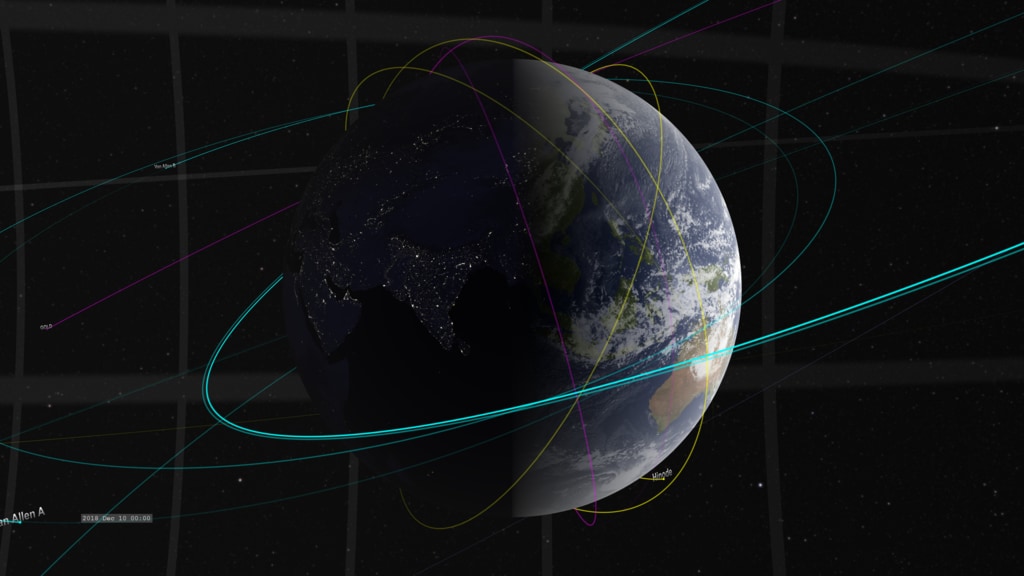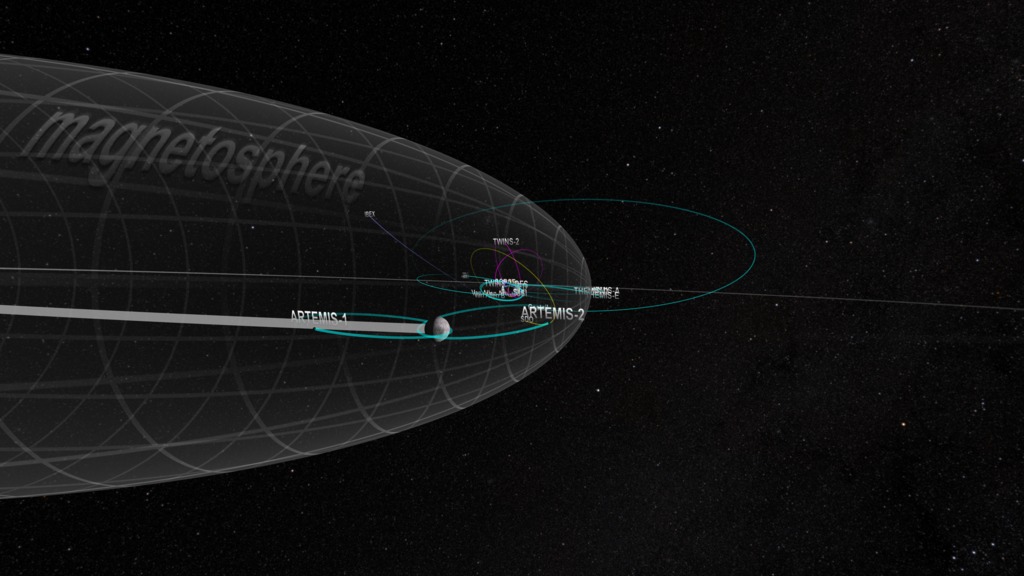A newer version of this visualization is available.
Heliophysics Sentinels 2017
This visualization starts from near Earth and the Earth orbiting satellite fleet out to the Moon, then past the Sun-Earth Lagrange point 1 to out beyond the heliopause. This is the long-play version.
There have been few changes since the 2015 Earth-Orbiting Heliophysics Fleet. As of summer 2017, here's a tour of the NASA Heliophysics fleet from the near-Earth satellites out to the Voyagers beyond the heliopause.
The satellite orbits are color coded for their observing program:
Magenta: TIM (Thermosphere, Ionosphere, Mesosphere) observations Yellow: solar observations and imagery Cyan: Geospace and magnetosphere Violet: Heliospheric observations
Near-Earth Fleet:
- Hinode: Observes the Sun in multiple wavelengths up to x-rays. SVS page
- RHESSI : Observes the Sun in x-rays and gamma-rays. SVS page
- TIMED: Studies the upper layers (40-110 miles up) of Earth's atmosphere. SVS page
- SORCE: Monitors solar intensity across a broad range of the electromagnetic spectrum.
- AIM: Images and measures noctilucent clouds. SVS page
- Van Allen Probes: Two probes moving along the same orbit designed to study the impact of space weather on Earth's radiation belts. SVS page
- TWINS: Two Wide-Angle Imaging Neutral-Atom Spectrometers are two probes observing the Earth with neutral atom imagers.
- IRIS: Interface Region Imaging Spectrograph is designed to take high-resolution spectra and images of the region between the solar photosphere and solar atmosphere. SVS page
Geosynchronous Fleet:
- SDO: Solar Dynamics Observatory keeps the Sun under continuous observation at 16 megapixel resolution. SVS page
Geospace Fleet:
- Geotail: Conducts measurements of electrons and ions in the Earth's magnetotail. SVS page
- Magnetospheric Multi-scale (MMS): This is a group of four satellites which fly in formation to measure how particles and fields in the magnetosphere vary in space and time. SVS page
- THEMIS: This is a fleet of three satellites to study how magnetospheric instabilities produce substorms. Two of the original five satellites were moved into lunar orbit to become ARTEMIS.SVS page
- IBEX: The Interstellar Boundary Explorer measures the flux of neutral atoms from the heliopause. SVS page
Lunar Orbiting Fleet:
- ARTEMIS: Two of the THEMIS satellites were moved into lunar orbit to study the interaction of the Earth's magnetosphere with the Moon. SVS page
Sun-Earth Lagrange Point One Fleet:
The L1 point is a Lagrange Point between the Sun and the Earth. Spacecraft can orbit this location for continuous coverage of the Sun.- SOHO: Studies the Sun with cameras and a multitude of other instruments. SVS page
- ACE: Measures the composition and characteristics of the solar wind. SVS page
- Wind: Measures particle flows and fields in the solar wind. SVS page
Solar Orbiting Fleet:
- STEREO-A & STEREO-B: The two STEREO spaceraft orbit the Sun in roughly the same orbit as Earth. There have been some communications problems with STEREO-B since 2014. SVS page
Interstellar Fleet:
- Voyager 1 & Voyager 2: The two Voyager spaceraft orbit originally performed flybys of the outer planets of the solar system but continued to operate. They are now the most distant monitors of the plasma in the space between the stars. SVS page
- L1 fleet, STEREOs and Voyagers added
- CINDI de-orbited and removed
- Camera move extended to out beyond the heliopause
This visualization starts from near Earth and the Earth orbiting satellite fleet out to the Moon, then past the Sun-Earth Lagrange point 1 to out beyond the heliopause. This is the short-play version.
Credits
Please give credit for this item to:
NASA's Scientific Visualization Studio
-
Visualizer
- Tom Bridgman (Global Science and Technology, Inc.)
-
Technical support
- Laurence Schuler (ADNET Systems, Inc.)
- Ian Jones (ADNET Systems, Inc.)
Release date
This page was originally published on Wednesday, October 25, 2017.
This page was last updated on Wednesday, November 15, 2023 at 12:11 AM EST.
Missions
This visualization is related to the following missions:Series
This visualization can be found in the following series:Datasets used in this visualization
-
SSCweb ephemerides (SSCweb)
ID: 538Satellite ephemerides
This dataset can be found at: http://sscweb.gsfc.nasa.gov
See all pages that use this dataset -
JPL/Horizon Orbital Ephemerides
ID: 597Planetary ephemerides
This dataset can be found at: http://ssd.jpl.nasa.gov/?horizons
See all pages that use this dataset -
Space-Track TLE (Space-Track Two-Line Elements)
ID: 753Satellite ephemerides
This dataset can be found at: http://Space-Track.org
See all pages that use this dataset -
DE 431
ID: 985Planetary ephemerides SPICE kernel
See all pages that use this dataset
Note: While we identify the data sets used in these visualizations, we do not store any further details, nor the data sets themselves on our site.

